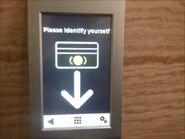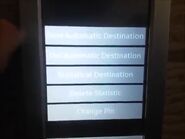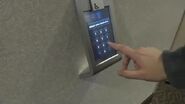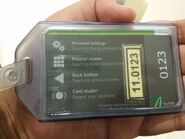
Schindler PORT (PORT stands for Personal Occupant Requirement Terminal), officially known as The PORT Technology is a destination dispatch system by Schindler. Unveiled in 2009, it is the successor of both Schindler Miconic 10 and Schindler ID.
Background[]
Schindler was the first elevator company to pioneered destination dispatch elevator system. They launched the Miconic 10 system in 1992 as the first practical destination control system in the world. Then in 2000, they launched a second generation of destination control system SchindlerID. These two successful systems led to the creation of a third generation system; the Personal Occupant Requirement Terminal, or simply known as PORT was launched in 2009 as a successor of both Miconic 10 and SchindlerID. The first PORT installation was successfully installed at the International Commerce Centre in Hong Kong, the city's current tallest building.
Description[]
Schindler PORT is a destination control system powered by intelligent software that runs on a highly advanced algorithm that continuously reviews building traffic patterns and systematically optimizes traffic handling efficiency throughout the day.
Passenger simply select their desired floor destination using the LCD touch screens found in the elevator lobby, either installed on the wall or a standalone pillar. After the passenger select his/her destination, the system predicts which is the best car to responds the nearest hall call. Once the destination is registered, the touch screen shows the allocated elevator car the passenger will take to get to their destination. The journey is then completely automatic.
Like Miconic 10 and other destination dispatch elevators, elevators with PORT Technology do not have visible floor buttons on the car station (except for firefighters during Fire Service Mode). Instead, only door control and alarm buttons are available.
Application[]
Schindler PORT is currently supported on the Schindler 5000, 5500, 7000 and 2000 series elevators.
The system is mainly used in high rise office buildings, but it can also be used in hotels, residential buildings and even shopping centers. It can also be used for modernization of older conventional elevators regardless of brand, as well as for upgrading Schindler elevators with Miconic 10/Schindler ID systems.
System features[]
Access control[]
The PORT Technology has an elevator assignment feature, which allows a pre-programmed card to generate an automatic elevator assignment at the barrier.
It also has the ability to blocks elevator departure if unauthorised entry to the lobby is detected and prevents use of a card by a second party if passed back across the barrier by the original user (anti-pass back). Also it can invalidates or limits operation of the card if not used when required for access. The user’s card could be rendered invalid and the user would only be allowed to return to the lobby or other designated area for reactivation.
[]
The PORT Technology uses a unique approach to help minimize the negative impact if individual cars are unavailable. This approach provides service at certain low-volume floors by making a stop at the floor above the destination floor of arriving passengers or at a floor below for departing ones. Passengers are then requested to walk down one level at either the beginning or end of their journey.
This simple action reduces the number of stops and therefore allows quicker returns to the lobby with a corresponding increase in handling capacity. It is only undertaken on a very limited basis and will affect as few people as possible consistent with maintaining overall efficiency. The feature and its benefits are clearly explained to the tenants ahead of time to avoid any issues and, of course, the disabled and other special groups are excluded from the limited need to walk.
The PORT terminal allows clear instructions to be given to passengers, both when they register a destination and again in the car. What it ultimately achieves is the highest possible level of service during reduced elevator availability.
Emergency evacuation[]
When certain emergency situations arise which require evacuation, the elevators could play an important role in helping to accomplish it in a timely and orderly fashion. While an evacuation plan is the responsibility of the building management working with the appropriate authority, the PORT technology offers an approach which is substantially ahead of any system currently available.
The PORT Technology uses the exclusive PORT to provide clear passenger instructions to help ensure that anyone approaching the elevator lobby can be informed as to whether they should wait for elevator service or take the stairs.
When elevator service is provided, the number of cars, based on current population data, required to evacuate an entire floor will, where practical, arrive together.
Operation[]
Normal operation[]
Passengers selects their desired floor by simply touching the available floor and proceed to the allocated car shown on the touchscreen.
Operation by RFID card[]
This is only valid when there are restricted floors, barrier gates and a "Please Identify Yourself" message is displayed on the touchscreen.
- Automatic destination: If a passenger presents a programmed card that only accept one specific floor, an elevator will be allocated as soon as the card is presented. The floor on the programmed card can be optionally changed by presenting the card and going to the setting (marked by a gear button) on the touchscreen. If the card is presented on a PORT controlled barrier gate, an elevator, depending on the situation, maybe immediately allocated or the screen may simply display an entry or exit message.
- Non-automatic destination: If there is no automatic destination and a card is still required to be presented, passengers simply present their card and selects their floor. In some cases, there will be a list of available floors shown on the screen and each floors are highlighted in turn. Passengers need to hold their card on the reader and remove it once their desired floor is highlighted.
Notable installations[]
Main article: List of notable Schindler PORT elevator installations
Gallery[]
Videos[]
Trivia[]
- The PORT technology also meets the Hong Kong's "Design Manual - Barrier Free Access 2008 (BFA 2008)" standard which was revised in September, 2015[1] for destination dispatch as well, while the voiceover provides Cantonese, Putonghua and English speech.
- The RFID cards can sometimes be programmed for more than one floor. Usually this is for the building staff/managers and/or firefighters for special use only.
Notes and references[]
- ↑ "Design Manual - Barrier Free Access 2008 (BFA 2008)" - Corrigendum (September 2015), Buildings Department, HKSAR, China.
See also[]
- Schindler Miconic 10 - the predecessor of PORT.
- SchindlerID - also a predecessor of PORT.
External links[]
- Official website
- PORT Technology - Schindler Group
- PORT Technology - Schindler North America
- The PORT Technology YouTube channel
| Destination dispatch elevator | |
|---|---|
| Main article | Destination dispatch |
| Systems by manufacturers | AGILE (TK Elevator, formerly DSC) • Compass / CompassPlus / Compass 360 (Otis) • Destination / Polaris (Kone) • Destination Oriented Allocation System (DOAS) (Mitsubishi Electric) • Destination Selection Control (DSC) (thyssenkrupp) • Destination Selecting System (Hyundai) • EZShuttle (Fujitec) • FIBEE (Hitachi) • FLOORNAVI (Toshiba) • Miconic 10 (Schindler) • The PORT Technology (Schindler) • SchindlerID (Schindler) |





















